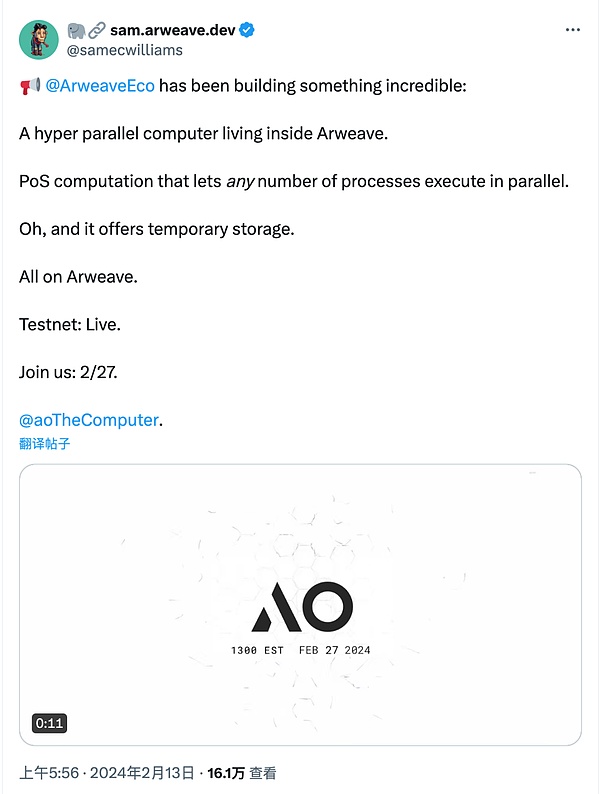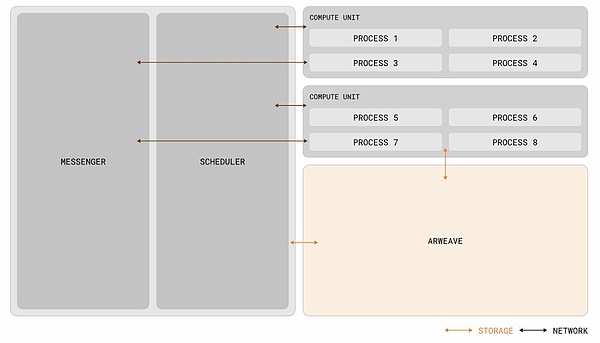At the beginning of February 2024, OpenAI released Sora, the first large-scale Vincent video model, opening a new page for the development of artificial intelligence. On February 13, the famous blockchain storage project Arweave Founder Sam announced on Twitter that Arweave has officially launched the super-parallel computer AO, which supports the introduction of large AI models into smart contracts on the blockchain. As soon as this information came out, it quickly caused a stir in AI and blockchain. There was a heated discussion among relevant people in the chain.
https://twitter.com/samecwilliams/status/1757161860028150159

Basic introduction
What is Arweave

Arweave is a new type of blockchain storage network designed to solve the problem of permanent data storage and access. Arweave features a method called “persistent storage” that ensures information is never lost by storing data on the blockchain. Arweave's crypto-economic model is designed to incentivize users to store and transmit data and ensure the security and reliability of the network, which allows users to safely store important data such as documents, pictures, videos, etc. and access these data at any time without Worry about data loss.
In particular, Arweave has shown its unique advantages in the NFT field. NFTs often require data to be stored off-chain, and if that data is lost or altered, the NFT will lose its meaning. Arweave provides a solution that allows NFT-related data to be stored permanently, thus ensuring the long-term value and significance of NFTs. Platforms such as Opensea and Mintbase have strategically cooperated with Arweave, and the NFT project Metaplex on the Solana chain also uses Arweave as the default tool for metadata storage.
Arweave is also committed to projects that permanently preserve human knowledge and history, and is known as the "eternal Library of Alexandria on the blockchain."
What is AO

AO is a distributed, decentralized, Actor-oriented (Actor Oriented) based on Arweave computing system.
Actor is the basic unit of a concurrent computing model in computer science. Actor-oriented refers to a method based on the Actor model. In this method, each Actors can modify their assigned private status, but if you want to modify the status of other Actors, you can only modify it indirectly by sending messages. It is suitable for building a high-concurrency, distributed, and fault-tolerant system. This is why the project is named AO.
AO consists of three units:

Communication unit (Messenger Unit): Responsible for message communication and passing messages to the computing unit and coordinate to calculate the output results;
Scheduler Unit: Responsible for scheduling and message sorting, and uploading messages to Arweave ;
Compute Unit: Responsible for processing calculations and uploading calculation results to Arweave.
AO Through the orchestration of the blockchain, each unit can be used as a horizontally scalable subnet to execute a large number of tasks at the same time. transactions, thereby enabling high-performance computing and theoretically providing nearly unlimited computing performance.
AO's core goal is to enable trustless and collaborative computing services without any practical scale constraints, which provides a combined block for applications A new paradigm of blockchain. Compared with other high-performance blockchains such as Solana, Aptos and Sui, AO can support the storage of large amounts of data, such as AI models; at the same time, compared with Ethereum which can only use a single shared memory space, AO also allows any number of Parallel processes operate simultaneously in computing units and cooperate with other units through open message passing, without relying on centralized memory space.

What is AOS
AOS is an official decentralized operating system built by Arweave based on AO. Its functions are similar to smart contracts. , but the contract development language is Lua.
Lua is a concise, lightweight, and extensible scripting language that is very different from our common smart contract languages Solidity, Rust and Move.
AOS allows developers to start a command line process and start issuing commands. The development experience provided to developers is similar to creating a new server instance on Alibaba Cloud and passing it through SSH to it, except that this command line process has the properties of a smart contract, which means that these commands not only enable seamless user interaction across the network, but also have decentralized and trustless computing as a key advantage.
Advantages of AO

The essence of AO is a decentralized cloud service based on SCP (Storage-based Consensus Paradigm) , there are three progressive relationships, namely "cloud service", "decentralized cloud service" and "decentralized cloud service based on SCP".
I believe everyone is already familiar with cloud services, and there is no need to elaborate on their importance. They have become an important infrastructure in the era of big data, but almost all of them are provided by central It is built and controlled by global giants, such as Amazon Web Services (AWS), Google Cloud Platform (GCP), Microsoft Azure in foreign countries, and Alibaba Cloud, Tencent Cloud, and Huawei Cloud in China.
Decentralized cloud services refer to the use of blockchain economic incentives to realize the sharing and exchange of cloud resources in a decentralized network. Users can transfer their Processing power, storage space or bandwidth is provided to the network to obtain digital currency or tokens. They can then use these digital currencies or tokens to access services.
Decentralized cloud services rely on market forces to determine the value and allocation of computer power, storage space and bandwidth. It enables more efficient and direct resource allocation, This economic structure encourages users to participate in the network and fair competition, which not only strengthens the cloud infrastructure, but also breaks the situation controlled by giants, because all the underlying processing power, storage space and bandwidth are provided by users. Once a decentralized cloud The economic structure of the service network no longer applies. Users can choose to exit the network or join the network of other decentralized cloud services. This limits the space for service providers of decentralized cloud service networks to "do evil".
Well-known projects in the decentralized cloud service track include Dfinity, Ankr, Akash, etc. In fact, we can add here that Arweave itself can also be classified as decentralized Cloud service track, but only provides a single cloud storage service.
One of the challenges of decentralized cloud services is that consensus mechanisms can be complex and difficult to implement because they require nodes in the network to agree on data storage and retrieval . SCP is one of the effective ways to solve this challenge. SCP is a storage-based consensus paradigm. Its core idea is that as long as the storage is immutable, the above transactions are traceable, so no matter where the calculation is application, will get the same results.
AO By uploading all pre- and post-calculation states, as well as input and output to Arweave, any third party can download all data, run the execution environment (such as a virtual machine) and execute the inputs sequentially to obtain the final consistent result. In this way, permissionless verifiability is achieved and a trustless consensus is achieved.
This means that AO can achieve distributed verifiable calculations, which is also the biggest advantage of AO compared to other decentralized cloud services.
Summary: The significance of AO to AI

The evolution of AI requires algorithms, computing power and data. With the joint promotion of these key factors, for some emerging AI companies, in order to reduce costs and obtain more computing power, they have no choice but to cooperate with cloud service giants. After all, not all companies have the ability to build their own computing power and carry out AI application development will also increase demand for cloud services. At the same time, cloud service giants will also develop their own AI systems. It can now be seen that almost all centralized cloud service providers have developed their own generative large models.
In this relationship of cooperation and competition, the cloud service giant puts AI emerging companies in a position of dominance through its monopoly on computing power and dominance of cloud services. Extremely disadvantaged position, this kind of competitive relationship that does not strive for innovation and financial resources will ultimately harm the interests of users.
Decentralized cloud services can balance this unfair competitive relationship and attract users to participate in the network to contribute computing power and data. I believe that in the future in the AI era Will definitely become a new player.
Arweave launches AO from the vertical decentralized storage track to the broader decentralized cloud service track. Its permanent on-chain storage is no longer just It stores user data separately but serves as a permanent host for cloud computing. It focuses on unlimited expansion of large-scale verifiable calculations, which infinitely enhances its imagination and aims to become the number one player in the AI era.
 JinseFinance
JinseFinance
 JinseFinance
JinseFinance JinseFinance
JinseFinance JinseFinance
JinseFinance JinseFinance
JinseFinance JinseFinance
JinseFinance JinseFinance
JinseFinance JinseFinance
JinseFinance JinseFinance
JinseFinance JinseFinance
JinseFinance JinseFinance
JinseFinance